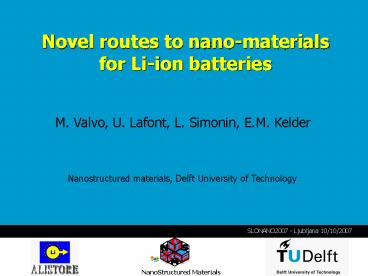Novel routes to nanomaterials for Liion batteries - PowerPoint PPT Presentation
1 / 35
Title: Novel routes to nanomaterials for Liion batteries
1
Novel routes to nano-materials for Li-ion
batteries
M. Valvo, U. Lafont, L. Simonin, E.M. Kelder
Nanostructured materials, Delft University of
Technology
SLONANO2007 - Ljubljana 10/10/2007
2
Outline
- Present scenario for Li-ion batteries
- Metallic nanoparticles for negative electrodes
- Overview of the techniques
- Synthesized materials
- Conclusions and outlooks
3
- Advanced Li-ion batteries requires
- Higher storage capacities (gravimetric
volumetric energy densities) - Longer cycle lives
- Improved safety and contained costs.
- Why nanoparticles and nanocomposites?
- Larger surface areas ? enhanced charge transfer
- Shorter migration lengths for charge carriers ?
increased power delivery - Reduced volume of host particles ? effective
acceptance of local strain - Material mixing on the nanoscale ? improved
mechanical stability - Extended interface ? electron and ion storage in
neighbouring phases.
4
Li insertion in carbonaceous materials
- 6C Li e- ? LiC6
Theoretical capacity 370 mAhg-1
The host structure is preserved during the
process!
5
Li alloys alternative negative electrodes?
Example
Sn
- 5 Sn 22 Li 22 e- ? Li22Sn5
J.R. Dahn et al. Solid State Ionics 111 (1998)
289 294
6
Metallic alloyed nanoparticles!!
- Different approaches
- Composite materials
- Particle size reduction
- Buffering of growing phases
- Absolute volume changes reduction
- Improved kinetics for Li-alloying
Unconventional synthesis techniques
- Spark Discharge Generator (SDG)
- Electrostatic Spray Reductive Precipitation
(ESRP)
7
Spark Discharge Generator
How to make the electrodes?
Main
ideas1. A capacitor is continuously charged by
a HV power supply2. A fast discharge occurs
through the gap between the electrodes
when the breakdown voltage of the system is
reached 3. Evaporation of electrode material
and generation of ultrafine charged
particles via spark discharge
- Universal and simple method
- Tuning of the particle properties (i.e. size,
size distribution) - High purity for produced materials
- High yield of charged particles
- Possibility for scaling-up
8
Nanoparticles produced by densification and
atomization processes
L. Simonin et al. J. Power Sources In press
9
(No Transcript)
10
Results for SnSb powders
11
Liquid atomization by Electrospraying
- Multi-jet modes enable higher flow rates
12
Electrostatic Spray Reductive Precipitation
Main ideas1.
Generation of a charged aerosol by high voltage
between a nozzle and a counter electrode 2.
Reduction of the precursor ions contained in
the sprayed droplets and particle formation
- Beneficial combination of top-down bottom-up
approaches - Tuning of the particle ensemble properties (i.e.
particle size, size distribution) - Easy scaling-up of the process
Example Reductive precipitation of metal
chlorides
13
Operation under different spraying modes
2 kV
9 kV
Cone-jet mode
Multi cone-jet mode
14
Results for Sn particles
15
Electrochemical test for Sn particles by ESRP
16
Conclusions and outlooks
- SDG and ESRP are promising techniques for the
synthesis of metal and alloyed nanoparticles - Monodispersed particles can be easily obtained
- Reducing the particle size increases the amount
of surface oxides - Stable cycling behaviour with Sn particles by ESRP
- Reducing the degree of oxidation of the materials
by handling the products under a controlled
atmosphere - Improvement of the overall reversible capacity of
the electrodes
17
Acknowledgements
- Battery group
- NSM section
- ALISTORE network
Thanks for your attention!
18
Additional slides
19
Battery performances scenario
J.-M. Tarascon M. Armand, Nature Vol. 414 (2001)
20
Magnetic Pulse Compaction (MPC)
Compaction is performed by releasing a high
current into a solenoid, causing induced Lorentz
forces on the walls of a metal tube.
21
Alloy and intermetallic particles via ESRP
PUMP
Precursors
Reductive solution
22
EHDA in the cone-jet mode
Scaling laws for droplet size and current
Hartman et al. 1999. Scaling laws for droplet
size and current produced in the cone-jet.
Institute of Physics conference series
23
Sn commercial material
Sn by reductive precipitation
24
Sn ESRP 3 kV
Sn ESRP 9 kV
25
Cut-off voltage 0.05 1.2 V
Cut-off voltage 0 2 V
26
Cycle performances with different cut-off
voltages
27
Near-equilibrium profile for charge/discharge
1. Irreversible conversion reaction 2.
Reversible alloying/dealloying
I. A. Courtney and J. R. Dahn, J. Electrochem.
Soc. , 144, 2045 (1997)
28
(No Transcript)
29
Possible ways of reaction for intermetallics
30
Why are metals still attractive?
3828
372
LiC6
Li (metal)
31
Volume expansion
9
LiC6
J.O. BESENHARD Solid State Ionics 40/41 (1990)
525-529
32
Volume expansion
96
97
71
9
LiC6
LiZn
Li3As
LiAl
J.O. BESENHARD Solid State Ionics 40/41 (1990)
525-529
33
Li-ion Battery schematic
e-
R
Discharge
-
Li
xLi M xe- ? LixM
LiC6 ? Li e- 6C
Anode ? Oxidation
Cathode ? Reduction
M Mn2O4, CoO2 or NiO2
34
Li-ion Battery schematic
e-
Charge
-
Li
LixM ? xLi M xe-
Li 6C ? LiC6
Cathode ? Reduction
Anode ? Oxidation
M Mn2O4, CoO2 or NiO2
35
Faradays law
Theoretical capacity x ? number of electrons
passed in the reaction. F ? Faradays constant
(9.6494 104 C). Mw ? Molar mass of the active
material. Cth(Sn) 993 mAh/g
vs Cth(Graphite) 372 mAh/g































